The NVIDIA GeForce GTX 980 Ti Review
by Ryan Smith on May 31, 2015 6:00 PM ESTNVIDIA's Computex Announcements & The Test
Alongside the launch of the GTX 980 Ti, NVIDIA is also taking advantage of Computex to make a couple of other major technology announcements. Given the scope of these announcements we’re covering these in separate articles, but we’ll quickly go over the high points here as they pertain to the GTX 980 Ti.
G-Sync Variable Overdrive & Windowed Mode G-Sync
NVIDIA is announcing a slew of G-Sync products/technologies today, the most important of which is Mobile G-Sync for laptops. However as part of that launch, NVIDIA is also finally confirming that all G-Sync products, including existing desktop G-Sync products, feature support for G-Sync variable overdrive. As the name implies, this is the ability to vary the amount of overdrive applied to a pixel based on a best-effort guess of when the next frame will arrive. This allows NVIDIA to continue to use pixel overdrive on G-Sync monitors to improve pixel response times and reduce ghosting, at a slight cost to color accuracy while in motion from errors in the frame time predictions.
Variable overdrive has been in G-Sync since the start, however until now NVIDIA has never confirmed its existence, with NVIDIA presumably keeping quiet about it for trade secret purposes. However now that displays supporting AMD’s Freesync implementation of DisplayPort Adaptive-Sync are out, NVIDIA is further clarifying how G-Sync works.
Meanwhile being freshly rolled out in NVIDIA’s latest drivers is support for Windowed Mode G-Sync. Before now, running a game in Windowed mode could cause stutters and tearing because once you are in Windowed mode, the image being output is composited by the Desktop Window Manager (DWM) in Windows. Even though a game might be outputting 200 frames per second, DWM will only refresh the image with its own timings. The off-screen buffer for applications can be updated many times before DWM updates the actual image on the display.
NVIDIA will now change this using their display driver, and when Windowed G-Sync is enabled, whichever window is the current active window will be the one that determines the refresh rate. That means if you have a game open, G-Sync can be leveraged to reduce screen tearing and stuttering, but if you then click on your email application, the refresh rate will switch back to whatever rate that application is using. Since this is not always going to be a perfect solution - without a fixed refresh rate, it's impossible to make every application perfectly line up with every other application - Windowed G-Sync can be enabled or disabled on a per-application basis, or just globally turned on or off.
GameWorks VR & Multi-Res Shading
Also being announced at Computex is a combination of new functionality and an overall rebranding for NVIDIA’s suite of VR technologies. First introduced alongside the GeForce GTX 980 in September as VR Direct, NVIDIA will be bringing their VR technologies in under the GameWorks umbrella of developer tools. The collection of technologies will now be called GameWorks VR, adding to the already significant collection of GameWorks tools and libraries.
On the feature front, the newly minted GameWorks VR will be getting a new feature dubbed Multi-Resolution Shading, or Multi-Res Shading for short. With multi-res shading, NVIDIA is looking to leverage the Maxwell 2 architecture’s Multi-Projection Acceleration in order to increase rendering efficiency and ultimately the overall performance of their GPUs in VR situations.
By reducing the resolution of video frames at the edges where there is already the most optical distortion/compression and the human eye is less sensitive, NVIDIA says that using multi-res shading can result in a 1.3x to 2x increase in pixel shader performance without noticeably compromising the image quality. Like many of the other technologies in the GameWorks VR toolkit this is an implementation of a suggested VR practice, however in NVIDIA’s case the company believes they have a significant technological advantage in implementing it thanks to multi-projection acceleration. With MPA to bring down the rendering cost of this feature, NVIDIA’s hardware can better take advantage of the performance advantages of this rendering approach, essentially making it an even more efficient method of VR rendering.
Getting Behind DirectX Feature Level 12_1
Finally, though not an outright announcement per-se, from a marketing perspective we should expect to see NVIDIA further promote their current technological lead in rendering features. The Maxwell 2 architecture is currently the only architecture to support DirectX feature level 12_1, and with DirectX 12 games due a bit later this year, NVIDIA sees that as an advantage to press.
For promotional purposes NVIDIA has put together a chart listing the different tiers of feature levels for DirectX 12, and to their credit this is a simple but elegant layout of the current feature level situation. The bulk of the advanced DirectX 12 features we saw Microsoft present at the GTX 980 launch are part of feature level 12_1, while the rest, and other functionality not fully exploited under DirectX 11 are part of the 12_0 feature level. The one exception to this is volume tiled resources, which is not part of either feature level and instead is part of a separate feature list for tiled resources that can be implemented at either feature level.
The Test
The press drivers for the launch of the GTX 980 Ti are release 352.90, which other than formally adding support for the new card is otherwise identical to the standing 352.86 drivers.
| CPU: | Intel Core i7-4960X @ 4.2GHz |
| Motherboard: | ASRock Fatal1ty X79 Professional |
| Power Supply: | Corsair AX1200i |
| Hard Disk: | Samsung SSD 840 EVO (750GB) |
| Memory: | G.Skill RipjawZ DDR3-1866 4 x 8GB (9-10-9-26) |
| Case: | NZXT Phantom 630 Windowed Edition |
| Monitor: | Asus PQ321 |
| Video Cards: | AMD Radeon R9 295X2 AMD Radeon R9 290X AMD Radeon HD 7970 NVIDIA GeForce GTX Titan X NVIDIA GeForce GTX 980 Ti NVIDIA GeForce GTX 980 NVIDIA GeForce GTX 780 Ti NVIDIA GeForce GTX 780 NVIDIA GeForce GTX 680 NVIDIA GeForce GTX 580 |
| Video Drivers: | NVIDIA Release 352.90 Beta AMD Catalyst Cat 15.5 Beta |
| OS: | Windows 8.1 Pro |


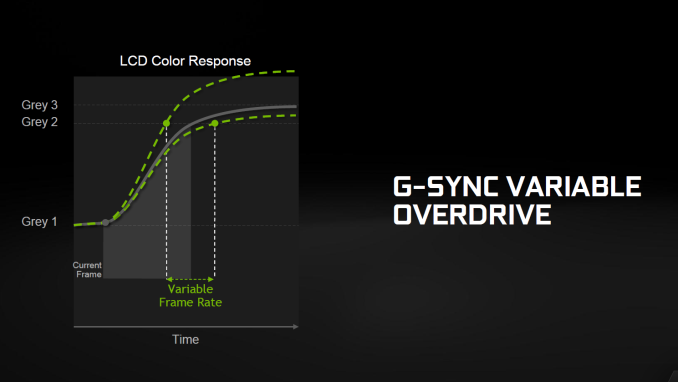
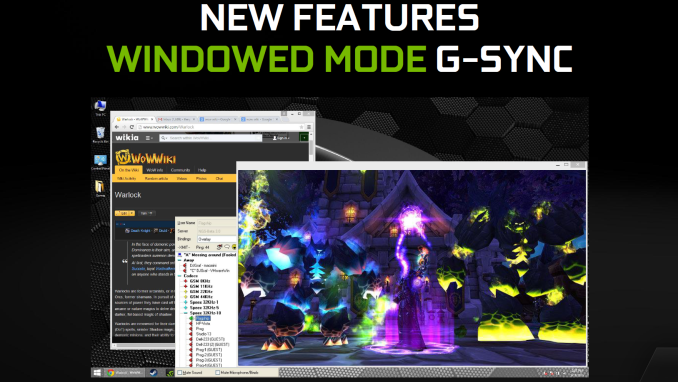
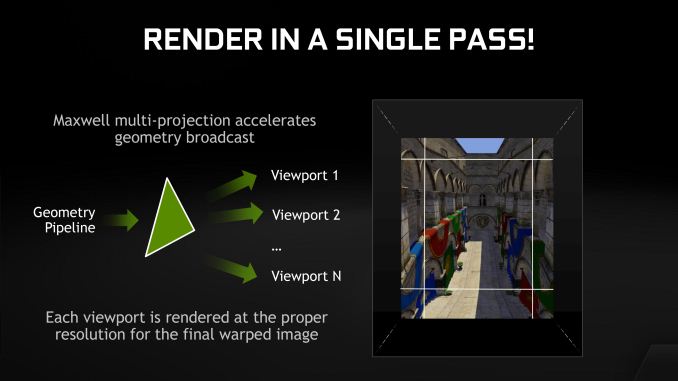
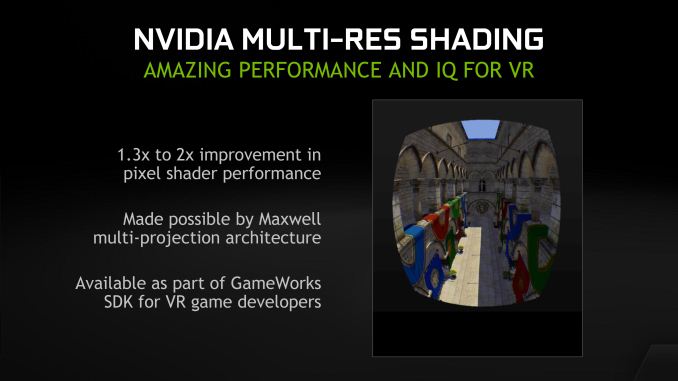
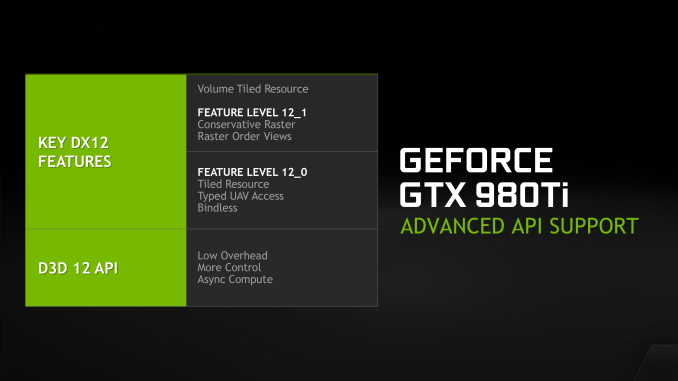








290 Comments
View All Comments
RaistlinZ - Sunday, May 31, 2015 - link
What more would a review of the 960 tell you that you don't already know, honestly? I'd rather read reviews about interesting products like the 980Ti. People need to let the 960 review go already, geez.Michael Bay - Sunday, May 31, 2015 - link
I only trust AT numbers and am in no hurry to upgrade.God I wish they would compare Baytrail/Cherrytrail to i3s.
Brett Howse - Sunday, May 31, 2015 - link
I did compare Cherry Trail to the i3 SP3 in the Surface 3 review. Was there more you were looking for?Michael Bay - Monday, June 1, 2015 - link
I`m trying to get a cheap small notebook for my father. He is currently on i3-380UM and the choice is between N3558 and i3-4030U. Workload is strictly internet browsing/ms office.Not much point in changing anything if performance is going to be worse than it was...
sandy105 - Monday, June 1, 2015 - link
Exactly , it would be interesting to see how much faster than baytrail they are ?DanNeely - Sunday, May 31, 2015 - link
DVI may be an obsolescent standard at this point; but 4/5k gaming is still expensive enough that a lot of the people buying into it now are ones who're upgrading from older 2560x1600 displays that don't do DP/HDMI 2. A lot of those people will probably keep using their old monitor as a secondary display after getting a new higher resolution one (I know I plan to); and good DL-DVI to display port adapters are still relatively expensive at ~$70. (There're cheaper ones; but they've all got lots of bad reviews from people who found they weren't operating reliably and were generating display artifacts: messed up scan lines.) Unless it dies first, I'd like to be able to keep using my existing NEC 3090 for a few more years without having to spend money on an expensive dongle.YazX_ - Sunday, May 31, 2015 - link
Dude, majority are still playing on 1920x1080 and just few now are making the leap to 2560x1440p, i have been gaming on 1440p since two years and not planning to go 4k anytime soon since hardware still not mature enough to play at 4k comfortably with single video card.thus, DVI is not going anywhere since dual layer DVI supports 1440p and probably most of 1080p gamers are using DVI unless if they have G-Sync or want to use Adaptive V-Sync then they have to use DP, and dont forget that there are too many people who bought 27" Korean 1440 monitors that doesnt have except DVI ports.
DanNeely - Sunday, May 31, 2015 - link
If you're playing at 1920/60hz this card's massive overkill, and in any event it's a non-issue for you because your monitor is only using a single link in the DVI and you can use a dirt cheap passive DVI-HDMI/DP adapter now; and worst case would only need a cheap single link adapter in the future.My comment was directed toward Ryan's comment on page 2 (near the bottom, above the last picture) suggesting that the DVI port wasn't really needed since any monitor it could drive wouldn't need this much horse power to run games.
FlushedBubblyJock - Wednesday, June 10, 2015 - link
totally disagree - I game at 1920x1200, the only rez the 980ti is capable of without knocking down the eye candy.Kutark - Monday, June 1, 2015 - link
Exactly. I literally just now upgraded to a 1440p monitor, and i can't even express in words how little of a sh*t i give about 4k gaming. Ive been a hardware nerd for a long time, but when i got into home theater i learned just how much resolution actually matters. 4k is overkill for a 120" projected image at a 15' seating distance. 4k at normal desk viewing distances is way beyond overkill. They've done tests on fighter pilots who have ridiculous vision, like 20/7.5 and such, and even they can't see a difference at those seating distances. 4k is almost as much of a marketing BS gimmick than 3D was for tv's.Anyways im clearly getting angry. But point still stands, every single gamer i know is still on 1080p, i was the first to splurge on a 1440p monitor. And now its put me into a position where my SLI'd 760's aren't really doing the deed, especially being 2gb cards. So, 980ti fits the bill for my gsync 144hz 1440p monitor just about perfectly.